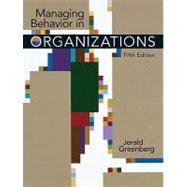Managing Behavior in Organizations provides a brief tour of the scientific and practical highlights of organizational behavior (OB).
The Field of Organizational Behavior; Organizational Justice, Ethics, and Corporate Social Responsibility; Psychological Processes in Organizations: Personality, Perception, and Learning; Coping with Organizational Life: Emotions and Stress; Work-Related Attitudes: Prejudice, Job Satisfaction, and Organizational Commitment; What Motivates People to Work?; Interpersonal Behavior in the Workplace; Organizational Communication; Group Processes and Work Teams; Making Decisions in Organizations; The Quest for Leadership; Culture, Creativity, and Innovation; Designing Effective Organizations; Managing Organizational Change: Strategic Planning and Organizational Development
MARKET: For readers who have no special background or training in the social sciences to use as a stand-alone guide to the essentials of OB.
In just 14 chapters, Jerald Greenberg offers up-to-date coverage of the major organizational behavior topics!
This new edition of Managing Behavior in Organizations helps students understand organizational behavior, its current theories and their value to modern organizational practice.
Look for these features in the new edition:
-"Making the Case for..." are brief opening cases in each chapter that illustrate the importance of the particular topic in an organization.
-Two new chapters including Chapter 3-"Personality, Feelings, and Stress" and Chapter 6-"Interpersonal Behavior in the Workplace"
-"Winning Practices"is a box included in each chapter that describes how organizational behavior principles were applied in a way that helped an organization improve.
-End of chapter elements including self-assessment exercises, group exercises, and "You Be the Consultant" mini cases.








